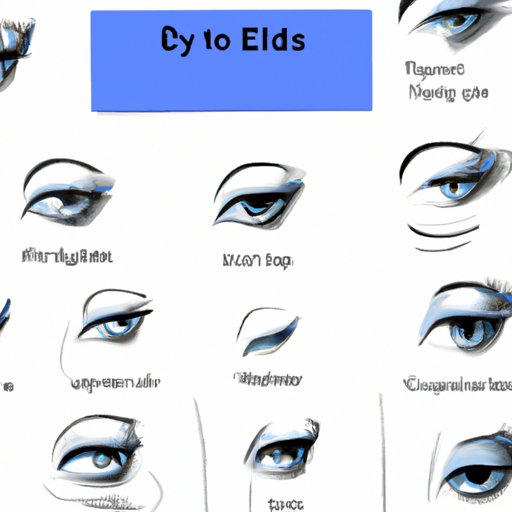
Introduction
Drawing eyes can be one of the most challenging aspects of creating realistic portraits. However, with the right skills and techniques, anyone can master the art of eye-drawing. This article provides a comprehensive guide for beginners to draw eyes step by step. We will cover various aspects such as basic shapes, adding intricate details, different techniques, and tips to convey emotions through eyes. Additionally, we will also offer specific guidance for drawing eyes in a cartoon style.
The Art of Eye-Drawing: A Beginner’s Guide
Eye-drawing can be made easier for beginners by using basic shapes as a foundation. Starting with basic shapes like ovals, circles, and rectangles can help to construct the basic outline of the eye. Once the basic shape is done, it’s time to add more details to make it look realistic.
To add more detail to your eye, you can start by drawing the iris, pupil, and highlight. Use your pencil to shade the pupil to make it look realistic. In addition, use a light source to determine the light and dark areas of the eye.
Step-by-step instructions can help make the process clear. Start by drawing an oval and marking the top and bottom. Draw a circle within the oval to form the iris and add a smaller circle inside of it for the pupil. Shade the pupil and add a brighter spot for the highlight.
Mastering the Art of Realistic Eyes: A Professional’s Perspective
An experienced artist can offer valuable guidance for those looking to create realistic-looking eyes. An artist’s perspective can provide specific details and illustrations of each step in the process, making it easier to follow and understand.
For instance, to create a realistic eye, one needs to understand the folds of the eyelid and how they affect the overall look of the eye. It’s important to understand the perspective of the eye to create an accurate representation in your artwork. Additionally, knowing about different eye shapes like almond or round eyes can help develop different styles and looks for the eyes.
Finally, tips to help achieve a realistic look include using a reference photo or model to match the elements of the eye. Use more than one reference photo to incorporate different elements from multiple eyes. Breaking down the eye’s different components will help view each aspect as a stand-alone element, resulting in a more realistic eye.
Sketching Eyes Made Simple: Techniques and Tips
Various techniques and tools can make drawing eyes easier. Shading, texture, and perspective can be tricky to master but can help to create better artwork. An artist needs to choose the right technique and tool for a specific result.
When shading the eye, use a light touch and observe the movement of the eye. Make sure the light is consistent and coming from the right direction. One of the essential aspects of eye-drawing is understanding the texture of the eye’s different parts. Use crosshatching and stippling techniques to include texture in your eye drawing. In terms of perspective, it’s vital to understand the three-dimensional space of the eye.
Certain tools can make the process easier; for instance, using a blending stump or tortillon can help to blend the shades and create a softer, smoother look. Different types of pencils (2H, HB, 2B, etc.) can be used to vary the shading intensity.
Express Yourself: Drawing Eyes That Convey Emotion
Drawing eyes that convey emotions can add depth, realism, and importance to your artwork. It’s essential to understand how different emotions manifest in the eyes, such as happiness, sadness, surprise, fear, and anger. One of the simplest tricks in drawing expressive eyes is tilting the eyebrow; for example, raised eyebrows indicate surprise or worry, while a furrowed brow communicates frustration or anger.
Furthermore, understanding how different parts of the eye change with emotions, such as smaller pupils in fear or wider lids in happiness, can transform your drawing’s emotion. It’s essential to practice doing this; look at yourself in the mirror and try to illustrate different emotions in your eyes.
Drawing Eyes for Comics and Cartoons: Tips and Tricks
Drawing eyes in the cartoon style can allow for more exaggerated features and playful expressions while still conveying emotions. Eyes can play a significant role in the specific style of your artwork. Learning some tips and tricks can help bring your cartoon eyes to life.
First, use larger pupils to exaggerate surprise or curiosity in the cartoon style. In contrast, smaller pupils can indicate feelings like fear or nervousness. Secondly, the shape of the eyes can vary in cartoon drawings to achieve a particular look or style. For instance, elongated slit pupils can add a sinister or villainous element to your drawing.
Finally, comic-style eyes allow for more variation in shading techniques and color; this is where experimentation comes in. Different ways to shade can create varying moods or feelings, such as using a heavy amount of black for a more distressed or brooding look.
Conclusion
The art of eye-drawing can take some time to master. There’s a lot of different aspects to consider, such as basic shapes, intricate details, realistic elements, emotional expression, and cartoon styles. However, it’s worth spending the time to develop your skills and understand the different techniques required to capture the essence of the eye in your artwork. The key to success is to practice regularly and keep experimenting with different styles. Remember, practice makes perfect.





